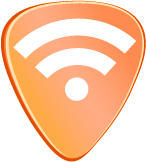 Since we were talking about guitars and how their pickups work, the Clear Science staff wanted to point out that all kinds of physics can be illustrated with a guitar. Take for example the vibration of the strings, which produces the notes. The strings are held stationary two places: at the nut, shown by the blue line, and at the bridge, shown by the grey line.
Since we were talking about guitars and how their pickups work, the Clear Science staff wanted to point out that all kinds of physics can be illustrated with a guitar. Take for example the vibration of the strings, which produces the notes. The strings are held stationary two places: at the nut, shown by the blue line, and at the bridge, shown by the grey line.When you pluck a string, you set up a standing wave, with stationary nodes at the nut and bridge. When you fret the string (i.e. push it down with your finger), you change the distance between these nodes, and it changes the note.
The 12th fret is exactly halfway along the string, and when fretted there will produce a note one octave higher than the unfretted string. (For example, the top string is generally an E, and the note at the 12th fret is a higher E.) The 7th fret is 2/3 of the way along the string, and the 5th fret is 3/4. These special frets are usually marked with pearling or with some dots.
via: http://clearscience.tumblr.com/post/3744206682/since-we-were-talking-about-guitars-and-how-their


Sem comentários:
Enviar um comentário